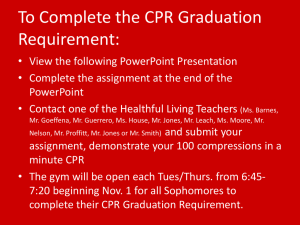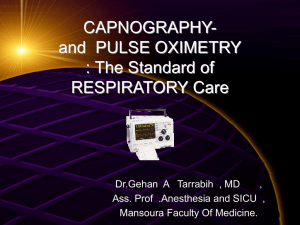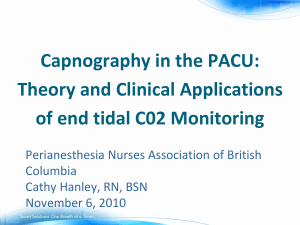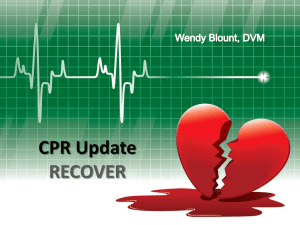CPR: Push Harder(er)
advertisement
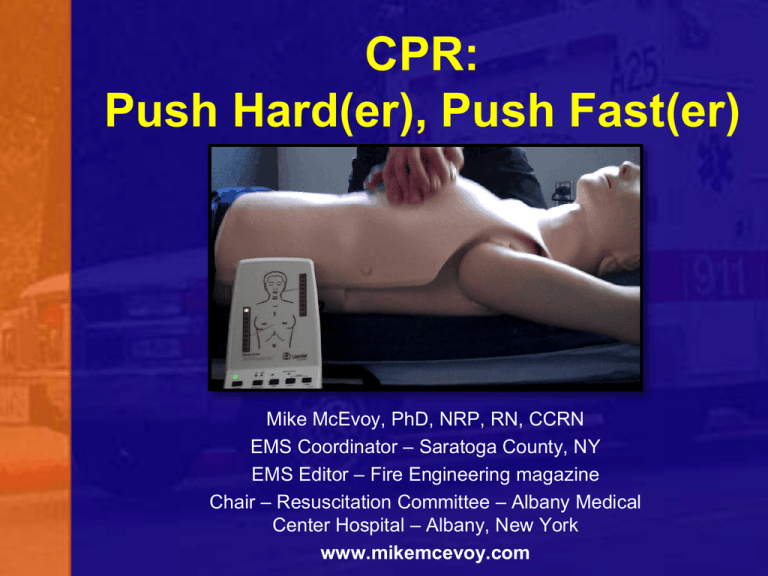
CPR: Push Hard(er), Push Fast(er) Mike McEvoy, PhD, NRP, RN, CCRN EMS Coordinator – Saratoga County, NY EMS Editor – Fire Engineering magazine Chair – Resuscitation Committee – Albany Medical Center Hospital – Albany, New York www.mikemcevoy.com Disclosures • I am on the Physio-Control Speakers Bureau • I don’t know how to play golf or ski www.mikemcevoy.com Outline • • • • • CPR 2010: that was then, this is now… Show me the money: is there proof? What matters? Why measure? How to assess quality CPR • Unique hospital issues • Future solutions Adult Chain of Survival: 2010 1. Immediate recognition and activation of emergency response system 2. Early CPR with emphasis on chest compressions 3. Rapid defibrillation 4. Effective ALS 5. Integrated post-cardiac arrest care CPR Sequence Change A-B-C to C-A-B Initiate chest compressions before ventilations Why? Reduce delay to compressions Can be started immediately Emphasizes importance of chest compressions So, What Matters in CPR? And how should we assess effectiveness? Chest Compressions 2010 2005 • > 50 mm ( > 2”) • 38 – 51 mm (1.5 – 2”) • At least 100 per minute • 100 per minute Most Common Errors: 1. Too slow 2. Not deep enough 3. Prolonged interruptions 4. Leaning Chest Compressions • ROC: survival associated with depth • Abella et al: 100-120/min = survival • Recommendations are both Class I, LOE C (just do it, because we like it) • In truth: – Ideal actual depth of CPR unknown • Probably lies near 50 mm – Best rate for CPR unknown • Is likely about 100/min CPR Rate vs. ROSC p < 0.0083 Abella et al. Circulation. 2005;111:428-434 Probability of ROSC Stiell et al. Crit Care Med 2012; 40:1192-1198 One Day Survival Stiell et al. Crit Care Med 2012; 40:1192-1198 Survival to Discharge Stiell et al. Crit Care Med 2012; 40:1192-1198 Effective CPR? • How do you measure the effectiveness of CPR? – End tidal carbon dioxide – Feedback devices • Measurement of CPR effectiveness is a proposed TJC future standard Waveform Capnography Attaches to ET tube, measures CO2 Physiology of Metabolism Oxygen Lungs alveoli blood Breath CO2 Muscles + Organs Lungs Oxygen CO2 Blood Oxygen ENERGY CO2 Cells Oxygen + Glucos e SpO2 versus EtCO2 Oxygenation and Ventilation Oxygenation (Pulse Ox) – O2 for metabolism – SpO2 measures % of O2 in RBCs – Reflects changes in oxygenation within 5 minutes Ventilation (Capnography) – CO2 from metabolism – EtCO2 measures exhaled CO2 at point of exit – Reflects changes in ventilation within 10 seconds Measuring Exhaled CO2 Colorimetric Capnometry Capnography Measuring Exhaled CO2 Colorimetric Capnometry Capnography Measuring Exhaled CO2 Colorimetric Capnometry Capnography Capnography Waveforms Normal 45 0 Hyperventilation 45 0 Hypoventilation 45 0 What about the Pulse Ox? Sp02 98 Carbon Dioxide (CO2) Production What If… But, with High-Quality CPR… Meet Howard Snitzer • 54-years old, collapsed Jan 5, 2011 outside Don’s Foods in Goodhue, MN (pop. 900) • 2 dozens rescuers took turns providing CPR for 96 minutes • 6 shocks with first responder AED, 6 more shocks by Mayo Clinic Air Flight Medics • Transported to Mayo Clinic Cardiac Cath Lab Why Not Quit? • Thrombectomy, stent to LAD • 10 days inpatient • “The capnography told us not to give up” • EtCO2 averaged 35 (range 32 – 37) So What’s the Goal During CPR? • Try to maintain a minimum EtCO2 of 10 • Push HARD (> 2”) FAST (at least 100) • Change rescuer Every 2 minutes Guidelines 2010 • Continuous quantitative waveform capnography recommended for intubated patients throughout periarrest period. In adults: 1. Confirm ETT placement 2. Monitor CPR quality 3. Detect ROSC with EtCO2 values Guidelines 2005 EtCO2 recommended to confirm ET tube placement EtCO2 detects ROSC • 90 pre-hospital intubated arrest patients • 16 survivors • 13 survivors: rapid rise in exhaled CO2 was the earliest indicator of ROSC • Before pulse or blood pressure were palpable Wayne MA, Levine RL, Miller CC. “Use of End-tidal Carbon Dioxide to Predict Outcome in Prehospital Cardiac Arrest” . Annals of Emergency Medicine. 1995; 25(6):762-767. Levine RL., Wayne MA., Miller CC. “End-tidal carbon dioxide and outcome of out-of-hospital cardiac arrest.” New England Journal of Medicine. 1997;337(5):301-306. Capnography = Results, not process Guidelines 2010: Evidence Capnography Classes & Levels of Evidence: 1. Confirm ETT placement: Class I, LOE A 2. Monitor CPR quality: Class IIb, LOE C 3. Detect ROSC with EtCO2: Class IIa, LOE B Classes of Evidence I – Standard of care: just do it! II – Conflicting evidence: maybe or not IIa – evidence favors benefit – do it IIb – evidence not so favorable – think first III – Not useful, maybe harmful: don’t do it Levels of Evidence: Proof A – A whole lotta proof: best! B – Some proof: better than nothing C – No proof: but some like the idea Guidelines 2010: Evidence Capnography Classes & Levels of Evidence: 1. Confirm ETT placement: Class I, LOE A Just do it, best proof 2. Monitor CPR quality: Class IIb, LOE C Think first, some like the idea 3. Detect ROSC with EtCO2: Class IIa, LOE B Do it, better than nothin’ CPR is Complicated! Hospital Issues: 1. Bed Height – Optimal = bed at knee level of person administering chest compressions Cho et al, Emerg Med J. 2009;26:807-810 2. Air Mattresses – No need to deflate mattress for CPR Perkins et al, Inten Care Med. 2003;29:2330-2335 3. Backboards – No evidence of benefit with backboard Perkins et al, Inten Care Med. 2003;29:2330-2335 What About Quality? In-Hospital Arrests, Dec 2004 – Dec 2005 Audiovisual CPR Feedback • Incorporated into monitor/defibrillator • Real time • Accelerometer-based Handheld Feedback Device Handheld accelerometer-based audiovisual device Generation of Feedback Post Code Reviews (Code Stat ™) EMS Feedback = ROSC • FDNY uses audio-visual feedback • Deactivated audio feedback for 1 week • ROSC 20% NY State EMS Council Report Jan 2012 But Hospitals ≠ EMS • How effective are feedback systems? We have a problem: Accelerometer CPR Depth Perkins et al. Resuscitation 2009;80:79-82 The Mattress Issue: • Mattress compression = 35 – 40% of total compression depth • Accelerometer feedback devices fail to account for mattress compression • Use of a backboard fails to compensate for mattress compression Perkins et al. Resuscitation 2009;80:79-82 The Solution: Directly measure the true compression depth. Triaxial Field Induction 1 2 • • • • Two end points Direct measurement of distance (magnetic) Discrimination of X, Y, Z Accommodation of Roll, Pitch and Yaw TFI versus ACC Banville et al. Circulation 2011; 124:A217 Summary • Compressions are key to outcomes – Most common errors: depth and speed • Need to assess effectiveness of CPR – It improves survival – Future TJC requirement • Current tools: EtCO2 and ACC – CO2 delayed – ACC inaccurate • Future: TFI – Very promising






